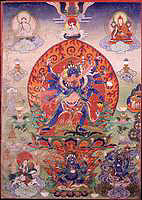
|
Tutelary Deity Chakrasamvara (painting no. 99)
|

View Larger Image |
||||||||||||||||
|
Chakrasamvara (Tibetan: kor lo de chog) with the consort Vajra Varahi (Tib.: dorje phag mo). Chakrasamvara is blue in colour with 4 faces, 12 hands and two legs. The faces are blue, yellow, green and white. The first two hands hold a vajra and bell and embrace the mother. The last two hold an elephant skin out-stretched; third right a damaru, fourth an axe, fifth a trident, sixth a curved knife. The third left holds a katvanga marked with a vajra; fourth a vajra noose, fifth a blood filled skullcup, sixth carries the four-faced head of Brahma. The right leg is straight and presses on the breast of red Kalaratri; left bent and presses on the head of black Yama;. Each head has a crown of five dry human skulls; a necklace of fifty fresh heads and bone ornaments; wear-ing a lower garment of tiger skin. In the lap is the Mother Vajra Varahi, with a body red in colour, one face, two hands and three eyes. The left holds a blood filled skullcup and embraces the Father, and the right, in a threatening gesture, holds a curved knife. The right and left legs em-brace the Father. Both Father-Mother stand in the middle of an orange fire of pristine awareness above a multi-coloured lotus and sun disc. Four initiation vases with skullcup caps surround the central figure; two on lotus blossoms and two wafting on blue and white clouds. At the top center sits buddha Akshobhya, blue, with one face and two hands; seated in vajra posture. Below that is the Tibetan yogi Milarepa, wearing a white cotton robe with a red meditation belt. The right hand is cupped to the ear and the left holds a skullcup; seated in a relaxed posture. To the left sits another yogi wearing the same style of garments. To the right side is a lama wearing monastic robes and a red pandita hat. In the right and left hands are a vajra and bell along with the stems of two lotus blossoms opening at each ear supporting a sword and book. Based on the iconographic signature this quite possibly is Jamyang Khyentse Wangpo (1820-1892). At the bottom center is the protector associated with the Chakrasamvara cycle of Tantras, Chaturbhuja Mahakala (Tib.: gonpo chag shi pa), dark blue, with one face and four hands. The first pair hold a curved knife and skullcup and the second a sword and trident. In front are two skullcups filled with offerings. To the left is the mountain goddessTseringma, with one face and two hands holding a vajra and wealth vase; riding a white snow lion with a green mane. To the right is Mahakali, dark blue, with one face and four hands holding a skullcup and spear in the first two and a sword and trident in the second two; riding on a brown mule. The landscape is populated by a yogi in a hermitage and another in the mountains, a caitya (reliquary structure), animals, a corpse and various auspicious objects of wealth. This ‘thangka’ is an excellent example of the new Karma Gadri style of painting. J.Watt 8-98
|
|||||||||||||||||
Photographed Image Copyright © 1998 Shelley & Donald Rubin Foundation
|
|
| |
Next Image |